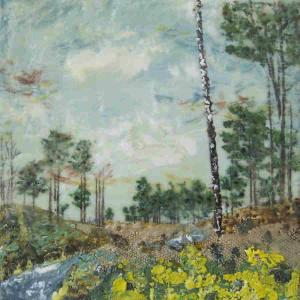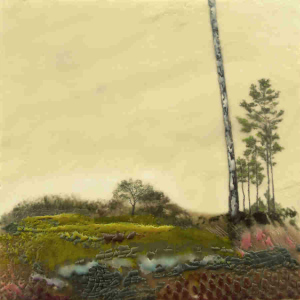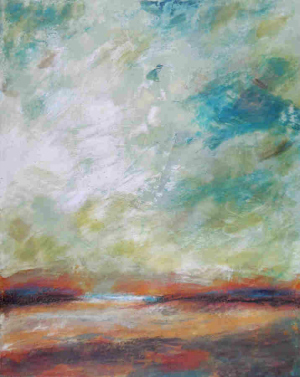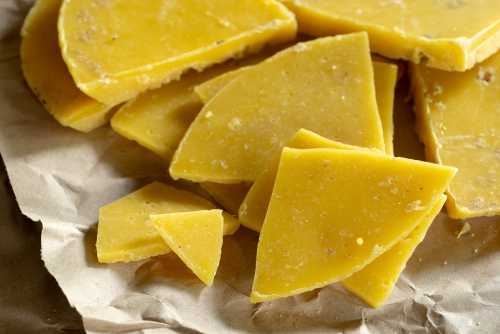Encaustic Art
The Art Of Painting
With Beeswax
I was already aware that that earlier civilisations have found an array of uses for various honey bee products.
However, I wonder how many people have heard of encaustic art – that is, the creation of artworks using a beeswax based paint? It’s certainly not something I knew about until recently.
Yet encaustic art has a rich heritage, certainly dating back to the ancient Greeks, and was used by Greek painters in Egypt in the 1st and 2nd centuries A.D. Indeed, beeswax was used in ancient cultures in a variety of ways.
Amazingly, encaustic art is still with us today!
Artist, Victoria Primicias tells us all about it, and shares with us the beauty
of this ancient technique.........
Q.A. With Artist, Victoria Primicias
BuzzAboutBees:
What
makes beeswax-based paint so special and different from other, conventional
paints?
Your paintings look beautiful, but I’m wondering whether there is
an added quality about them that cannot be experienced on a flat computer
screen.
Victoria Primicias:
Also known as encaustics, this ancient medium is made with beeswax,
colored pigment and damar, a tree resin. The paint is melted at 200F and
applied in 6–20 layers onto wood.
Layering creates a translucency and radiance that makes the painting
seem to glow from within. The quick drying time allows for an easy buildup of
texture, creating ridges that catch the light. Encaustic paintings do look better viewed in person
than on a screen.
 Above: Victoria Primicias last month in Sarasota, Florida, where she participated in a show (March 2014).
Above: Victoria Primicias last month in Sarasota, Florida, where she participated in a show (March 2014).BuzzAboutBees:
How is the beeswax prepared and applied? I there is a heating process involved. Is it a dangerous or difficult process?
Victoria Primicias:
The wax is applied with a brush onto a wooden panel, each layer fused
with a blow torch. The encaustic paint needs to be heated below 220F on a hot
palette; otherwise, irritants are released into the air. Because of this, I
keep a thermostat on my hot palette, and I use an exhaust fan in my studio.
 Encaustic paintings look even more beautiful when viewed in person.
Encaustic paintings look even more beautiful when viewed in person.BuzzAboutBees:
Do you combine other mediums with this one?
Victoria Primicias:
In the past, I used charcoal and carbon, and often embedded materials
such as sand, tree bark, and nails for added effect. Lately, though, I've been
using only oil pastels or oil sticks for final touches.
BuzzAboutBees:
From where do you get the inspiration for your beautiful paintings? I
note your website features abstract works, but most of them appear to be
inspired by the natural world – are they local scenes you are painting?
Victoria Primicias:
I worked as a graphic designer for 25 years, and evolved a personal
style that's classic, elegant and minimalist. I believe that aesthetic has
translated into my fine art paintings, even if I now use a tree in place of a
headline.
Also, I've lived in many diverse environments, mostly in large cities –
Manila, Toronto, Chicago – all near large bodies of water, a quiet respite from
city life.
I love beaches, sunsets, lakes, and vast oceans. I'm also a swimmer.
Now I live in Raleigh, NC where there is an abundance of pine trees. It
reminds me of Baguio, the picturesque mountain region in the Philippines where
our family often vacationed during school break.
Raleigh also reminds me of the
Muskokas, north of Toronto, a gorgeous area carved out by the glacial retreat
leaving hundreds of lakes, granite boulders rising out of the water, and pine
trees everywhere.
 Beautiful landscape painting by Victoria Primicias.
Beautiful landscape painting by Victoria Primicias.
BuzzAboutBees:
How do you acquire your medium? Do you keep bees yourself or do you
purchase from a specialist supplier? Is the beeswax treated prior to use,
and do subtle variations in colour affect the outcome of your paintings?
Victoria Primicias:
I purchase pharmaceutical-grade beeswax that's physically filtered to
remove pollen. It's not chemically bleached. Because of this, paintings will
not yellow over time. To color beeswax, I use powdered pigments that are
non-toxic.
BuzzAboutBees:
Your
paintings seem to express atmosphere. How does the medium of beeswax add to the
mood of your paintings?
Victoria Primicias:
The haunting beauty of atmospheric paintings by art masters such as Whistler
and Turner always appealed to me. I find this effect easy to achieve in
beeswax. Because each layer needs to be fused to the layer beneath for
durability, fusing softens the edges and allows colours to blend into each
other.
BuzzAboutBees:
What do
you most like about using beeswax? Is there anything you dislike about
it?
Victoria Primicias:
Beeswax has a translucent and radiant quality that cannot be achieved in
other mediums. It can also be highly textured, stimulating not only the sense
of sight but also the sense of touch.
It's a forgiving medium. If I make a mistake, it can easily be covered up with another layer of wax, or scraped back, with no adverse effects.
What I dislike about the medium is waiting for the wax to melt. Beeswax takes over an hour to reach the ideal molten temperature of 180-200F; therefore, picking up a brush to paint a few minutes here and there throughout the day is not an option. A hot palette needs attention and a time commitment.
 Victoria finds the haunting beauty of atmospheric paintings easy to achieve in beeswax.
Victoria finds the haunting beauty of atmospheric paintings easy to achieve in beeswax.
BuzzAboutBees:
Has the
interest and increased focus on bees helped to contribute to a revival in the
use of beeswax as an art medium?
Victoria Primicias:
The revival of beeswax painting is attributed to the American artist
Jasper Johns. In 1955, he was searching for ways to add more texture to his
"White Flag" painting when he rediscovered this ancient medium.
BuzzAboutBees:
I’m sure
people will be wondering……doesn’t it melt? How do you keep the paintings
clean?
Victoria Primicias:
Yes, the paintings will melt, but in order for this to happen, your
house has to be on fire. Levity aside, the addition of damar hardens the wax
and increases the melting point, so as long as you keep your home's thermostat
below 150F, the painting remains stable. After all, there are 600 surviving
encaustic works from 100–300 A.D. in Egypt, a testament to encaustic art’s
beauty and durability over the ages.
BuzzAboutBees:
Thank you for your time and for sharing your experience of Encaustic art with
us.
Victoria Primicias:
Thanks to you, too, for the thoroughness of your questions.
Would you like to know more about Victoria's beautiful art?
Victoria accepts commissions and ships her beeswax paintings globally.
You can find out more about Victoria and her art from her website, www.arte-cera.com
If you found this page helpful or interesting, I'd really be grateful if you would share it with others - if not this page, perhaps another, such as Gardening For Bees.
Thank you so much :) .
